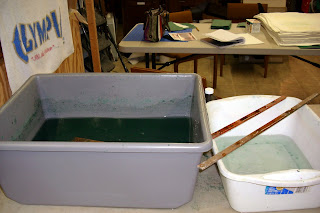No doubt I was excited about the paper making experience at Paper Circle, the paper and book arts gallery, at the historic Square in Nelsonville. But even more than the excitement, I was amazed by the enthusiasm of Sara Gilfert, the founder and art director of Paper Circle. Sara will turn 80 this June, but her energy and love for the paper art and the community, remain boundless. I interviewed her in the studio, and she generously shared with me the story behind Paper Circle and as mentioned in the previous posts, gave me a demonstration on handmade paper making.

The beginning
Before being “infected with the love of paper” Sara worked with fabric. She taught fiber art at Ohio University from 1980 to 1985: weaving, knitting, dyeing, crochet, batik, all the differnt things related to fiber. Her art studio at home was built around these fabric art techniques which she had learnt 10 years before that. She also owned a yarn shop at that time.
Introduction to paper making
Sara said she became interested in paper art in the late 1970s'. A friend introduced her to paper making at that time. As the luck would have it, in 1980 she had the chance to learn the art of Japanese paper making when she joined her husband on a visit to Chubu University in Japan, for three months. While in Japan, Sara had the opportunity she described as “god sent and wonderful,” to visit the studio of a Japanese paper artist. From him, she learnt the traditional Japanese method of paper making.
After returning from Japan, she slowly turned her fiber art studio into a paper art studio. In 1985, Ohio University closed the fabric art department, a nationwide trend at that time. As her interest in paper art grew, she let her lose the fabric art materials. She began using paper as the medium for her art; using paper for creating all kinds of imagery and forms.

Next 10 years or so she found herself to be extremely busy, helping her husband set up his engineering business. Though an artist at heart, Sara taught herself double entry book-keeping and learnt to run a small business, to help her husband. She smiled recounting how she learnt book keeping "the hard way." The accountant in me empathised with her.
Through this period, she intermittently worked in her studio.
Paper Circle: the concept
After almost 11 years, she longed to get back to the “full-time artist” job. "I better return to my studio becuase that's where I have my health," she recalled her thoguhts at that time. In 2001, the idea of the public funded “paper art gallery” was lingering her mind. Sara said she was thinking of a space where she could work with her fellow artists and share her knowledge and the eqipment for making paper, and her in interest paper art, with the community.
Then in 2001, a friend from ‘Rural Action’ joined her in her studio at home. She was Sara's first intern. They used to get together every week and Sara taught her the skills she knew. Within a year three more apprentices joined her. They brought together different talents and experimented with paper art in the studio. Sara also shared with them her "vision" of Paper Circle.
"Paper Circle" is born
Sara's studio at home was built for one person, so for four artists they needed a bigger place. Sara definitely had the “concept” of Paper Circle in mind that was bigger than just a studio and started to put the word out. They started looking around for a new place and that’s when they found the current place at Nelsonville’s historic Square. Paper Circle—“the circle round the Square,” (I used "The Circle Around the Square" phrase as a descriptor for Paper Circle but actually it is a name of the program offered by them for children) was inaugurated in 2003, with Rural Action as a fiscal agent. Sara moved the equipment from her home studio to the new studio.
I think with so many other art galleries and studios around, the Square seems to be a perfect venue for Paper Circle artists to continue with their artistic endeavours.
Paper Circle: then and now
When they moved, the place was in a bad shape. Sara recalled that walls were dark gray, ceiling was balck and the floor was a mess. "It took months of rehabilitation work," sara said " to convert it into a workable area."
Paper circle is now a nice space divided roughly in three sections. As you enter, there is a professional gallery area where exhibiitions are held. Then you step into a small section where art works of the Paper Circle artists are displayed. Here you see differnt types of handmade paper, leather bound books, colorful paper bowls and other wonderful art works, made from paper, pulp and paper mache. Further inside is the studio space where paper making equipment and other accessories are placed.
Mission
Paper Circle is a non profit organization with public funding. The organization's Web site sums up its mission very well: “Paper Circle is dedicated to the celebration, preservation and advancement of the paper and book arts.”
More about the artists and this hub of paper art in Southeast Ohio, in the next post!













